Fantasioso … creative, imaginative … Italian bars are like the people. “Prendiamo un caffè.” Let’s get a coffee. An Italian bar is always, and I mean always, a stone’s throw away. Italians love their coffee, that thimbleful of dark liquid they throw back with such style. It’s about the coffee, but it’s also about the ritual, the culture, maybe even in the DNA.
WHAT IS UN CAFFE’? AND AN ESPRESSO?
Un caffè is an Italian coffee, what Americans would call an espresso. In Italian, the term caffè espresso came about with the invention of an apparatus that was able to make coffee faster. Espresso means fast or express. Studies indicate that 97% of Italians drink coffee and that they polish off on average four tazzine (little cups) a day. Many are consumed at home, but Italians also make a noteworthy number of visits to bars.
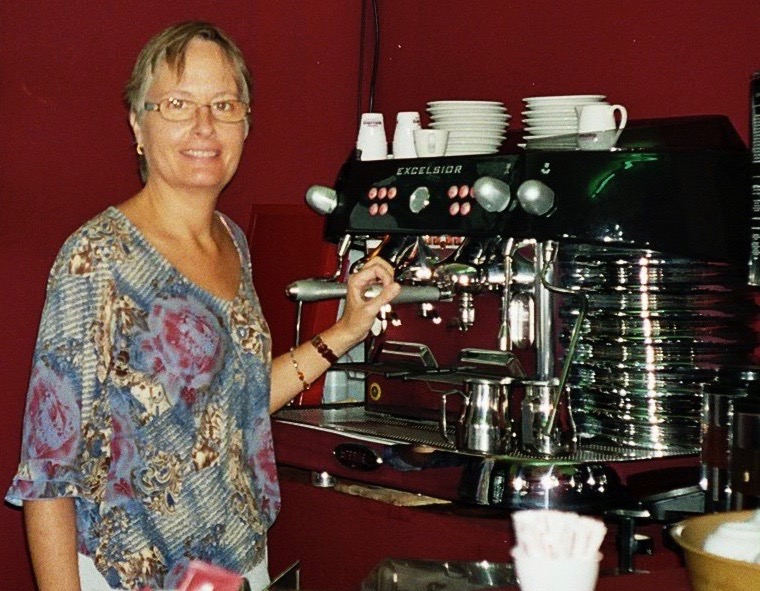
The Author playing barista
“Un caffè, per favore.” To the uninitiated, the customer orders a coffee at an Italian bar and is served a coffee; however, that doesn’t take into consideration Italian fantasia or the bravura of the barista as he makes that perfect caffè or skillfully executes a special request. A patron may order un caffè lungo, made with more water and thus weaker, un caffè ristretto/corto, made with less water and stronger, or un caffè doppio, a double. For a beverage with more liquid, there’s the caffè americano, a diluted espresso.
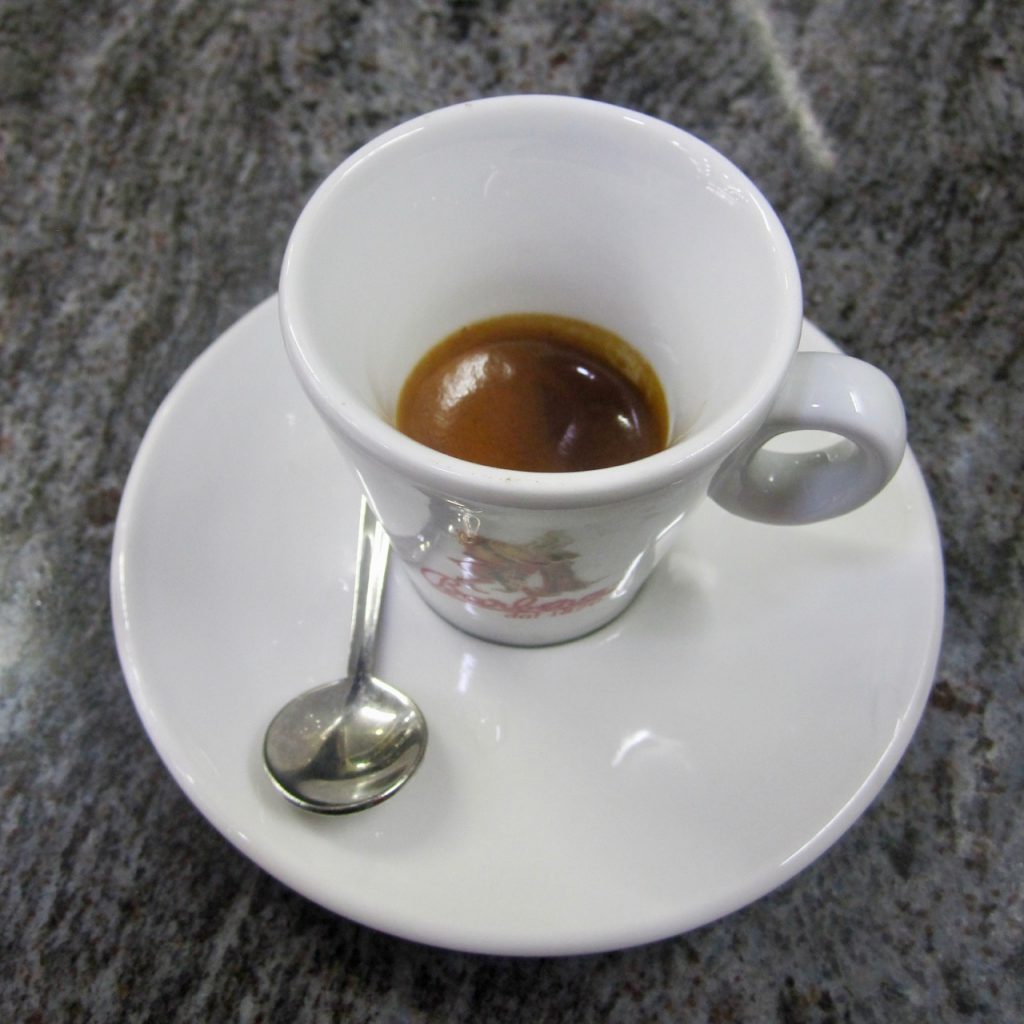
Un Caffè at Dolci Capricci in Reggio Calabria
And then there is un caffè macchiato, where the coffee is “marked” with a little milk, un caffè schiumato or “frothed” with a bit of milk foam, and un caffè coretto, in which it is “corrected” with some sort of alcohol, such as grappa, brandy or sambuca. In warm weather, what about un caffè shakerato, a sweet, creamy iced coffee, or un caffè freddo, a cold coffee? Have trouble with caffeine or coffee, itself? There’s caffè decaffeinato or Hag, a brand of decaffeinated coffee, or caffè d’orzo, barley coffee. But this is all just the tip of the coffee bean.
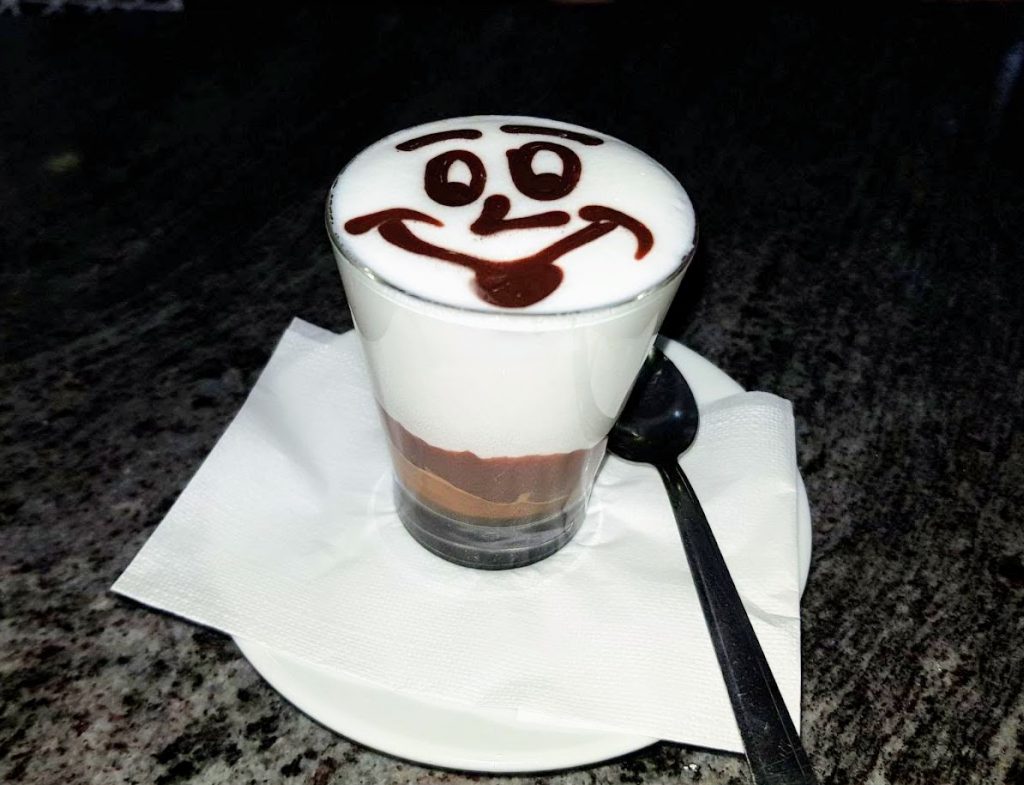
Caffè Venezia made with coffee, whipped cream and dark chocolate at Dolci Capricci in Reggio Calabria. Called a Marocchino in other parts of Italy.
THE MORNING CAFFELLATTE AND CAPPUCCINO
In the morning, caffè is also sipped with milk in a caffellatte (also written caffè latte or caffè e latte), latte macchiato or cappuccino.
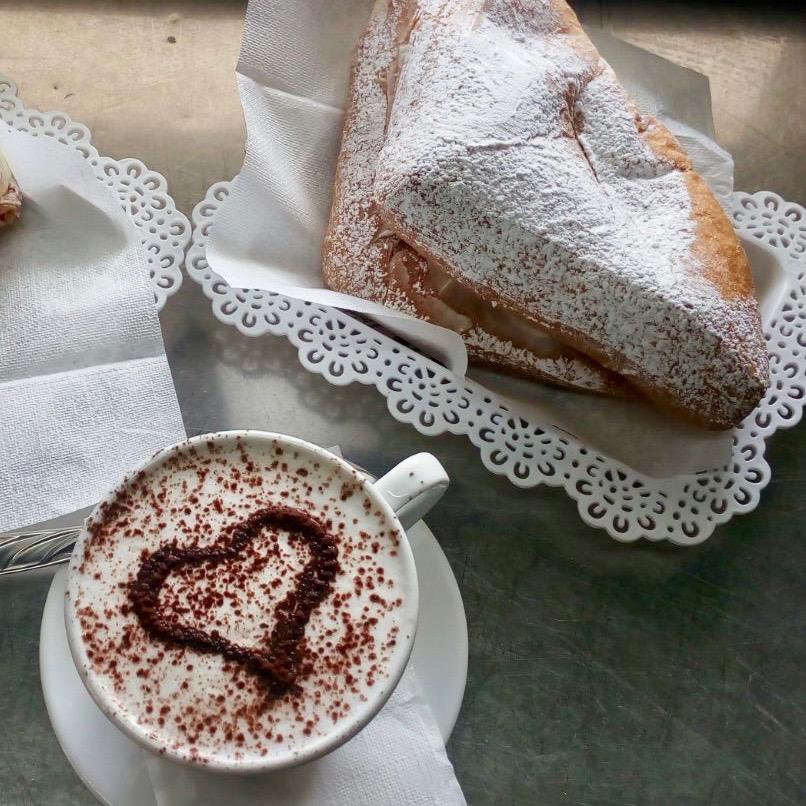
Un cappuccino e una sfoglia con la ricotta, Dolci Capricci, Reggio Calabria
The caffellatte is customarily called a latte in English and is prepared more often at home with personal preference determining the proportion of coffee to milk. Served in a large cup or small bowl, it consists of hot milk with about 1/4 to 1/5 caffè. A latte macchiato uses less coffee and is presented in a tall glass. A cappuccino is 1/4 coffee topped with milk steamed to a high foam.
Note to self: Italians do not order coffee with milk in the afternoon or evening.
THE ITALIAN BAR
C’è crisi. There’s an economic crisis. It’s been a hot topic for years or maybe it’s always been a hot topic, but in Italy there will forever be a place for dolci capricci or sweet whims. Coffee and pastry definitely fall into that category, along with much of Italian life. But perhaps it’s because un cappuccino e un cornetto at an Italian bar is a small price to pay for the reward. Alone or in company, with colleagues or friends, for the sheer pleasure or for work, drinking that little cup of coffee at various times throughout the day gives structure and lends a familiarity to meetings and breaks, whether professional or personal.
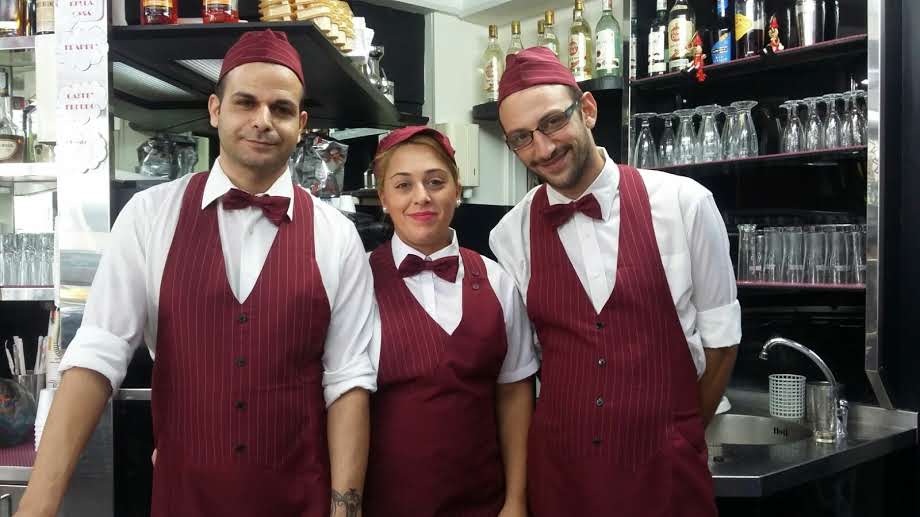
Mario, Jessica and Nico, a family of Baristi at Dolci Capricci in Reggio Calabria
The Italian bar is also frequented for the coffee, itself. In Italy, many believe that coffee made by a barista is better than what can be made at home, whether in a stove-top moka pot, countertop espresso appliance or the classic Napoletana (Neapolitan flip coffee pot). The bar’s caffè is thought to be a magic alchemy of variables such as temperature, humidity, composition of the water, quality and mix of coffee, not to mention the skills of the barista, who makes hundreds of tazzine a day. The resulting taste is stronger, creamier and more intense. But coffee isn’t the only reason Italian bars are so popular.
DOLCI CAPRICCI — PASTICCERIA, CAFFETTERIA, GELATERIA IN CALABRIA
Take “Dolci Capricci,” the bar catty-corner from Reggio Calabria’s Archeological Museum on Corso Garibaldi as an example. While a basic Italian bar will have a small case of dolci (sweets), such as a handful of cornetti (similar to croissants) for breakfast or a pick-me-up later in the day, many bars, like “Dolci Capricci” are also pasticcerie or pastry shops that sell a vast array of delicacies throughout the day and evening, both to eat in and take away.
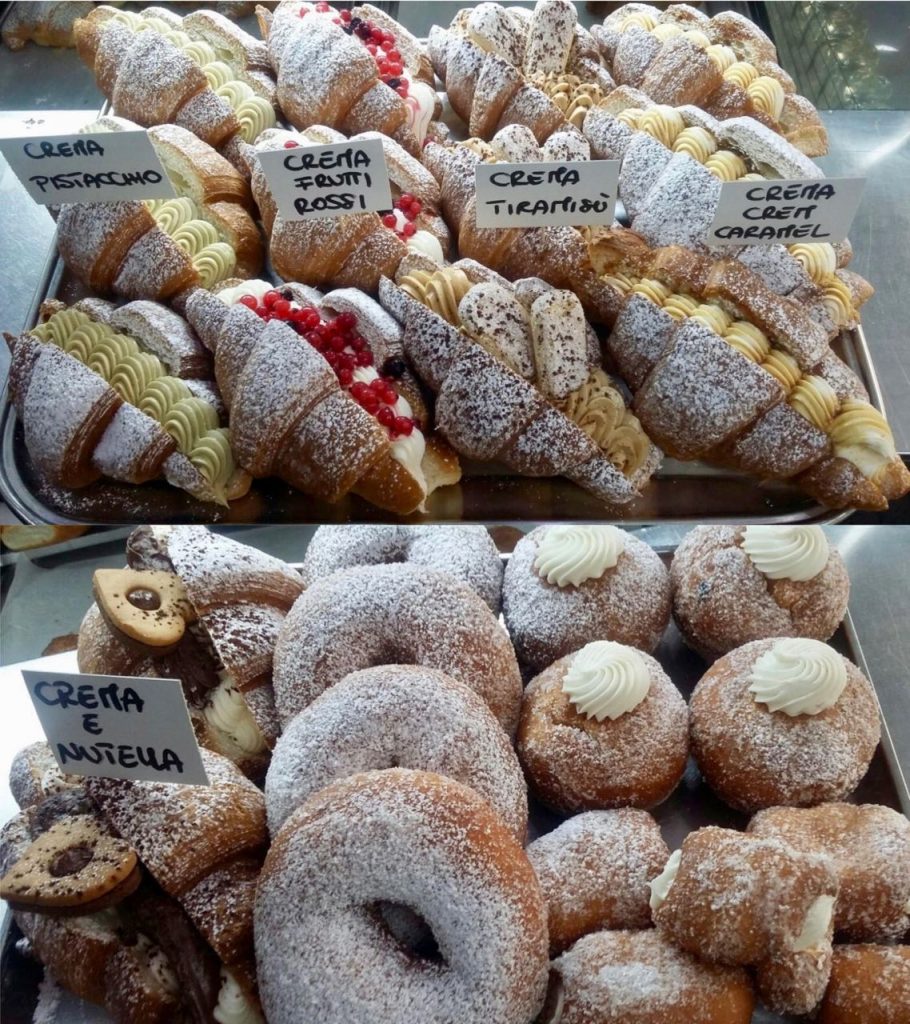
Assortment of cornetti filled with fresh pistachio cream, pastry cream with red berries, and creams of tiramisù, crème caramel and Nutella, doughnuts and other treats at Dolci Capricci in Reggio Calabria
The cornetto, plain or filled with apricot preserves, chocolate or cream, is a classic, especially for breakfast with a cappuccino or caffè. Pastries are excellent in Calabria and merit a blogpost in themselves—elaborate cream or ricotta-filled creations, flaky (sfoglia) or shortbread (frolla) pastries, the simple crostata (lattice-topped tart) or tea cookies, and specialties of the season.
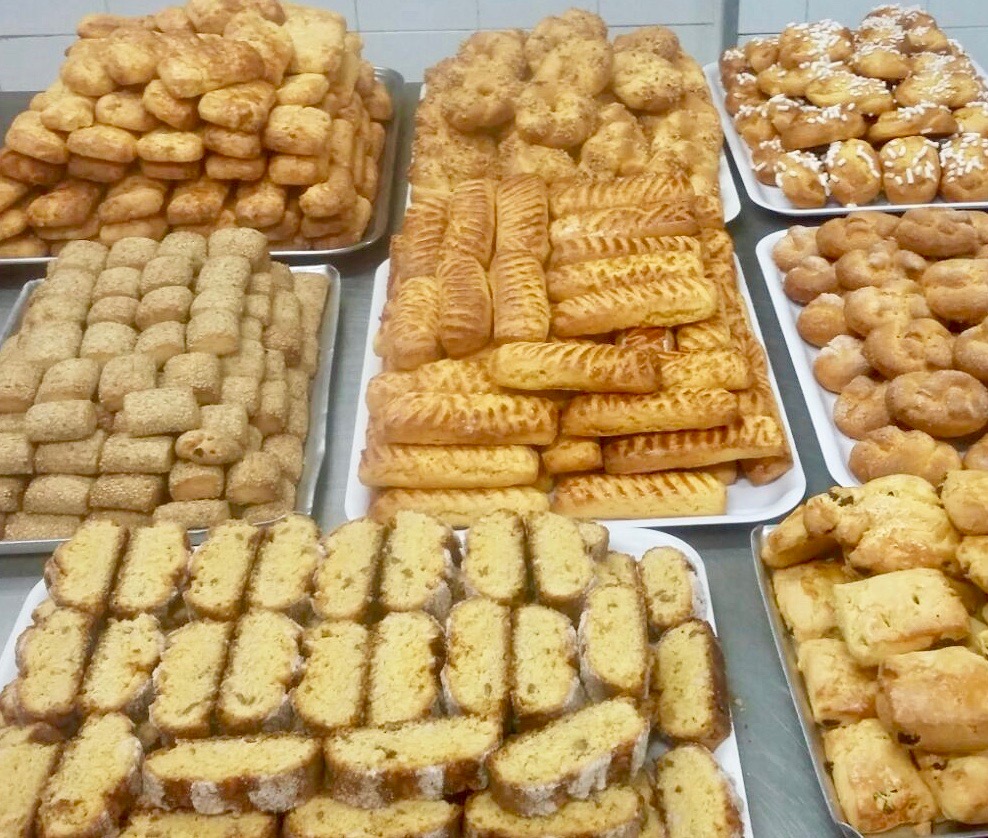
Sometimes I’m just in the mood for a simple, wholesome Italian cookie. Trays of cookies (including biscotti, sesame and bergamot) at Dolci Capricci in Reggio Calabria
As for terminology, a coffee bar or café can also be called a caffetteria, which indicates a locale with all the products normally associated with coffee and refreshments. The sweet tooth can also be satisfied with gelato, often just in warmer months, as with the granita, a semi-frozen treat made of sugar, water and fruit juice or other flavors. A tasty granita with a brioche makes for a refreshing summer breakfast or snack.
NOT JUST COFFEE AT AN ITALIAN BAR
Just because a friend invites you to drink a coffee together—“Ci beviamo un caffè”—doesn’t mean you have to drink un caffè or stand at the bar. While Italians enjoy rubbing elbows side-by-side, angled in or a couple of rows deep, most bars have tables (where the price understandably goes up) and sometimes even what could be described as a tea room. Perhaps I’m a creature of habit, but I like sitting down, and “Dolci Capricci” has a comfortable room that looks out onto Reggio’s Archeological Museum, home to the famous Riace Bronzes.
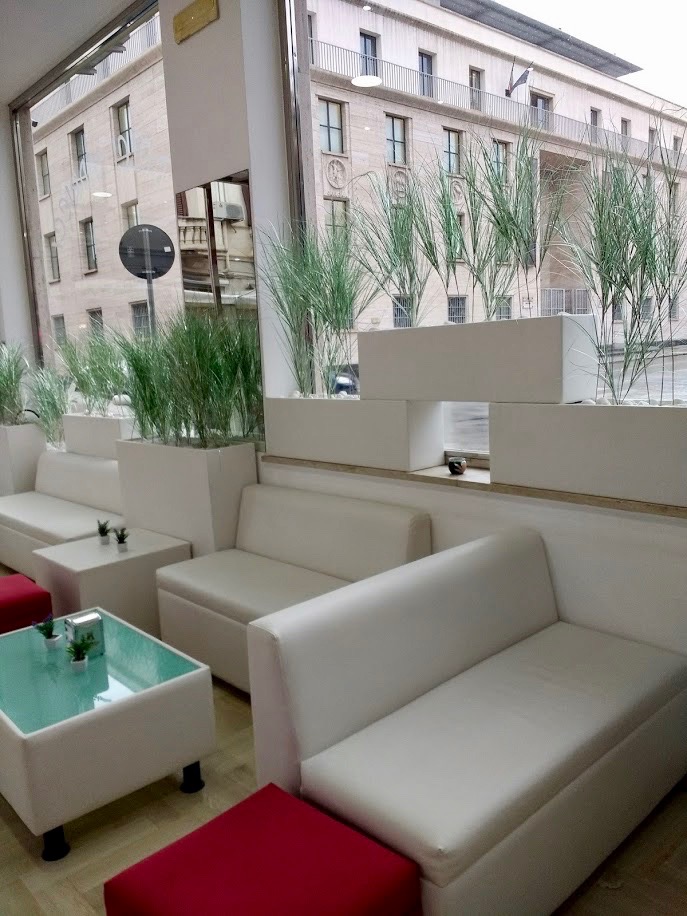
View of the Archeological Museum from Dolci Capricci Bar and Pastry Shop in Reggio Calabria
Beverage choices are surprisingly varied. When oranges are in season, there’s nothing I enjoy more than a spremuta d’arancia or fresh-squeezed orange juice. A local specialty amongst the bottled waters, juices and soft drinks is the “Bergamella,” a carbonated bergamot drink. Various teas and, in the winter, a very thick hot chocolate round out the choices of non-alcoholic drinks.
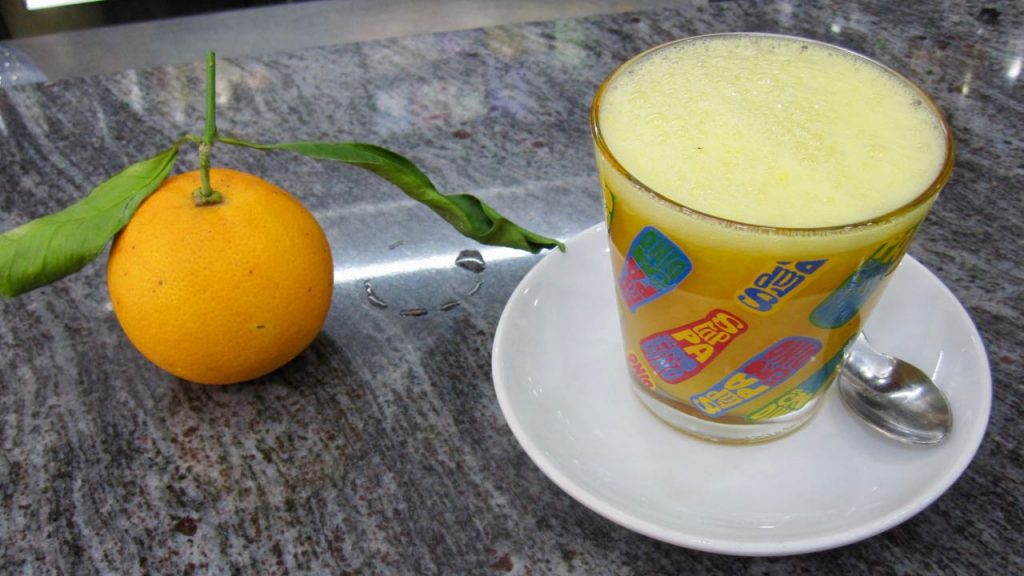
Una spremuta d’arancia, fresh-squeezed orange juice in an Italian bar, Dolci Capricci in Reggio Calabria
Alcoholic beverages are also an option in an Italian bar. How about a Campari and soda or a glass of wine? And what about a few savory nibbles to go with that drink? “Prendiamo un aperitivo!” Let’s have an aperitif, which often is extended to include stuzzichini or snacks. And in addition to fruit juices and such, bars always have an aperitivo analcolico, a non-alcoholic cocktail.
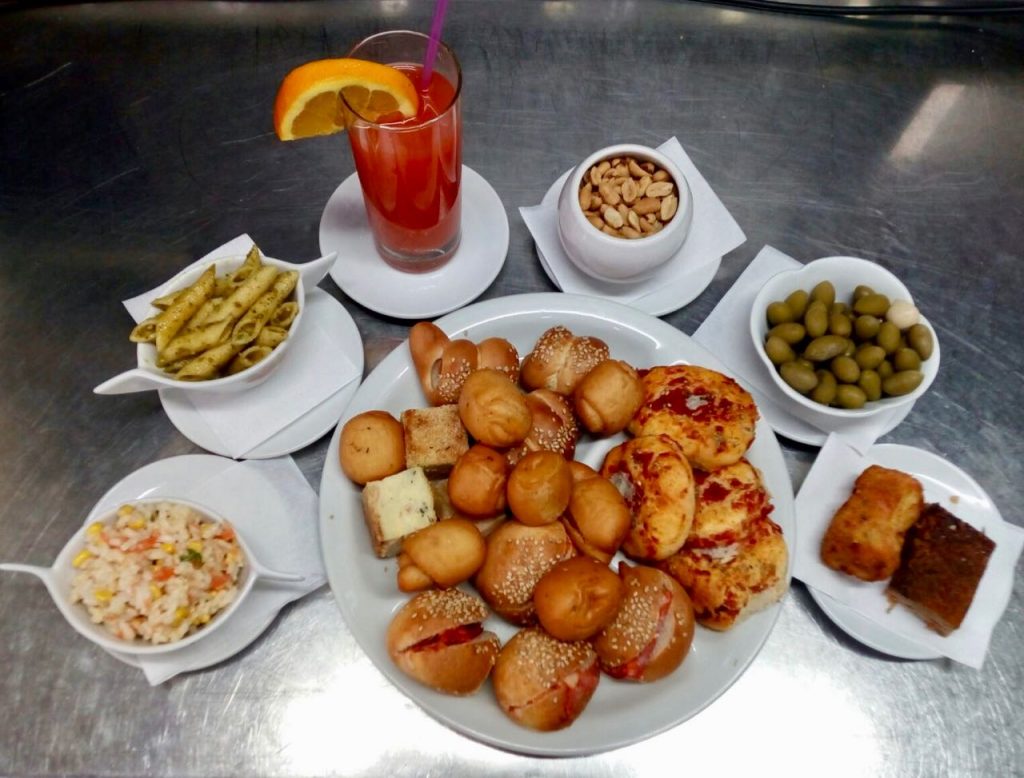
“Aperitivo” at Dolci Capricci Bar in Reggio Calabria
Still at a loss as to what to order in an Italian bar? In Calabria, you can never go wrong with an ice-cold glass of Vecchio Amaro del Capo. After all, this pleasant amaro is made with 29 herbs from the beautiful area of the region’s Capo Vaticano—it’s practically vegetable juice!
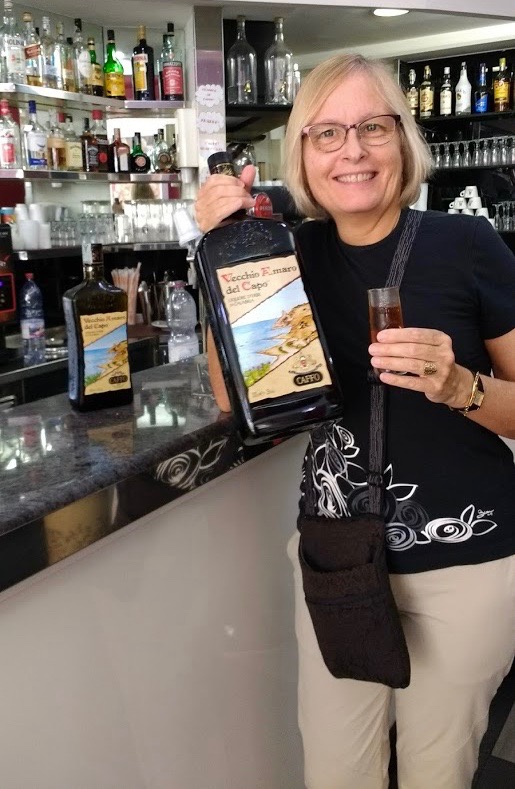
Enjoying a chilled Amaro del Capo at Dolci Capricci in Reggio Calabria
What are your favorite dolci capricci?
Dolci Capricci Bar is located at Corso Garibaldi, 41, diagonally across from the Archeological Museum in Reggio Calabria where the famous Riace Bronzes are on display. While visiting the “City of the Bergamot ,” don’t miss the Palazzo della Cultura, as well. Looking for a quick meal in Italy? Try a Tavola Calda.
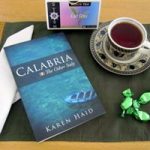 And for an in-depth look at the beautiful land in the toe of the boot, check out Calabria: The Other Italy, my non-fiction book about daily life, history, culture, art, food and society in this fascinating southern Italian region. It’s widely available in paperback and e-book versions, and also at the Dolci Capricci Italian Bar, which you can visit on my Calabria tour!
And for an in-depth look at the beautiful land in the toe of the boot, check out Calabria: The Other Italy, my non-fiction book about daily life, history, culture, art, food and society in this fascinating southern Italian region. It’s widely available in paperback and e-book versions, and also at the Dolci Capricci Italian Bar, which you can visit on my Calabria tour!
“Like” Calabria: The Other Italy’s Facebook page and follow me on Karen’s Instagram and Karen’s Twitter for more beautiful pictures and information.
Sign up below to receive the next blog post directly to your email for free.
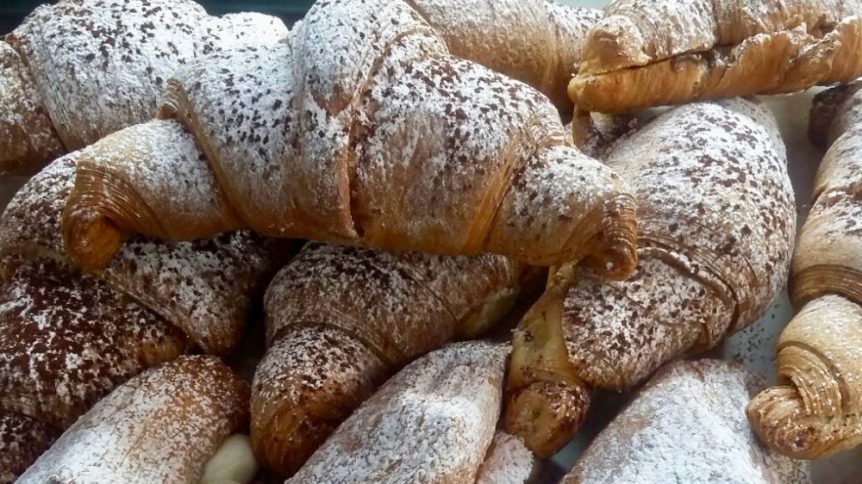
Comments 14
Very entertaining & informative! It all looked so tasty…
Author
Thanks – absolutely scrumptious!
I am reading this book a second time!!! Will be visiting Calabria soon! Special interest in Pente-Dattilo — Dattilo is my last name!
Author
I’m glad you’re enjoying my book. Dattilo is a name you hear often in Calabria. In addition to the chapter on Pentedattilo in my book, I also have a blogpost: https://www.calabriatheotheritaly.com/pentedattilo-calabria/
Have a wonderful trip!
This post is making me hungry. I’m also yearning to be back in Italy (but it’s not for a long time :() love that picture of you. Italian bars are so special!
Author
Ha, ha, very difficult to resist such delicacies! Thank you!
As always very entertaining, and very spot-on. Have you ever tried ginseng coffee, for me, decaffeinated.
Author
Thank you. I haven’t tried ginseng coffee – sounds a bit exotic …
I would NOT care to be tested on the names of ALL the various Caffè offered !!! The Dolci Capricci has a lovely table area! I too, enjoy sitting, as opposed to standing at the ‘bar’!
Great photos of all the food and …… YOU!
Author
No test – you only need to know what you like, and you can always ask. The table area is indeed a good place to relax and gaze out onto the museum and contemplate as to what’s inside, or to just sit and unwind. When I first moved to Calabria, I was amazed at the contemporary interiors in the many bars, even in small towns. (And thanks for the compliment!)
What a nice bar! I would like to see those Riace bronzes ‘in the flesh’ one day, so I will have to remember to stop in. My favourite bar fare is un espressino -called a marocchino everywhere but northern Puglia, and a sfogliatella or cornetto crema di pistacchio or crema amarena. I love Amaro del Capo too, but only if it’s cold. Nice foto of you and the amaro! Now I’m hungry and thirsty☕️🥐. Ciao, Cristina
Author
The Bronzes are worth the trip in themselves, but then there’s so much more in the museum, the city of Reggio and the entire area. I understand that the Venezia in the photo is Reggio’s version of the Marocchino/espressino, but the names certainly can get confusing. I agree that the Amaro del Capo is at its best when ice-cold in a chilled glass. I was just going to take a photo of the regular bottle and the glasses, but when I saw the giant bottle on the display shelf, I couldn’t resist being a part of it! Thank you, Cristina.
I need to get back to Reggio Calabria, and I’ll have to add this bar to my list of places to stop into. Those sweets look AMAZING! I always enjoy stopping at the bar with friends for un caffe! It’s such an important part of the culture here and it’s become a part of my everyday life here no doubt! Thanks for another great post!
Author
Reggio’s a great place to visit and the pastries are delicious! Thanks for your enthusiasm!